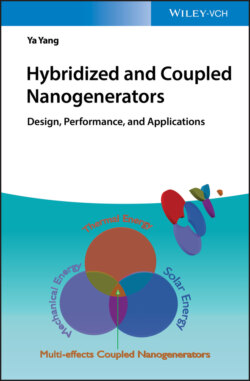Читать книгу Hybridized and Coupled Nanogenerators - Ya Yang - Страница 22
2 Wind‐Driven Triboelectric Nanogenerators 2.1 Introduction
ОглавлениеWind, a sustainable source of clean energy, has been widely used to conquer global warming and energy crisis, and about 4.3% of global electricity came from wind power by 2015 [1]. The electromagnetic wind turbine based on the electromagnetic effect is the main type of wind energy harvester [2–10]. However, this wind harvester can hardly be applied in our daily living environment owing to its inherent drawbacks, such as the complex structure, the large volume, and the requirement for high wind speed [11–17].
In order to adequately exploit wind energy and enforce the wind harvester on small electronic devices, it is necessary to develop new techniques to effectively utilize weak wind on miniaturized devices. Triboelectric nanogenerators (TENGs) based on a combined mechanism of contact electrification and electrostatic induction have been widely used to convert multiform mechanical energy to electric energy and showed outstanding advantages including simple structure, low cost, and high power density [18–27]. The wind‐driven triboelectric nanogenerator (WD‐TENG), an important portion of TENG family, is an ideal harvester for utilizing wind energy in the living environment. In this chapter, we will first review conventional wind energy harvesters and their applications. Special emphasis is given to the WD‐TENG including fundamental structures, materials, performance, and applications. We will conclude this chapter with a comparison between conventional wind energy harvesters and WD‐TENGs.
